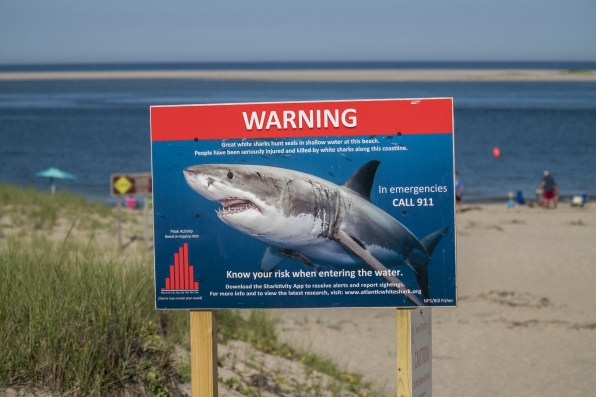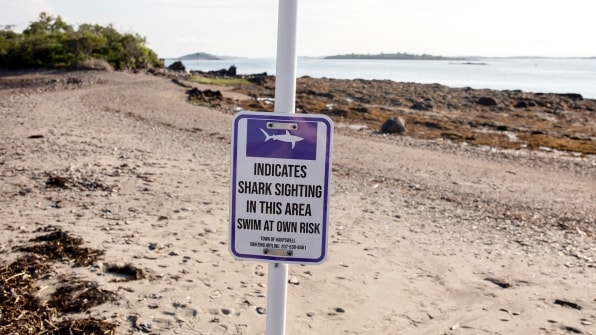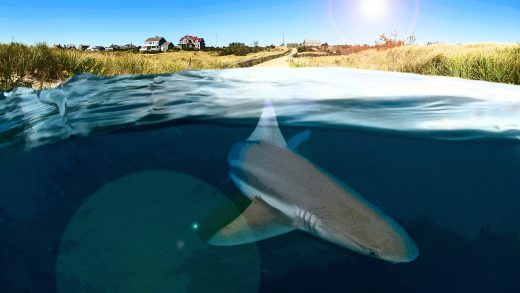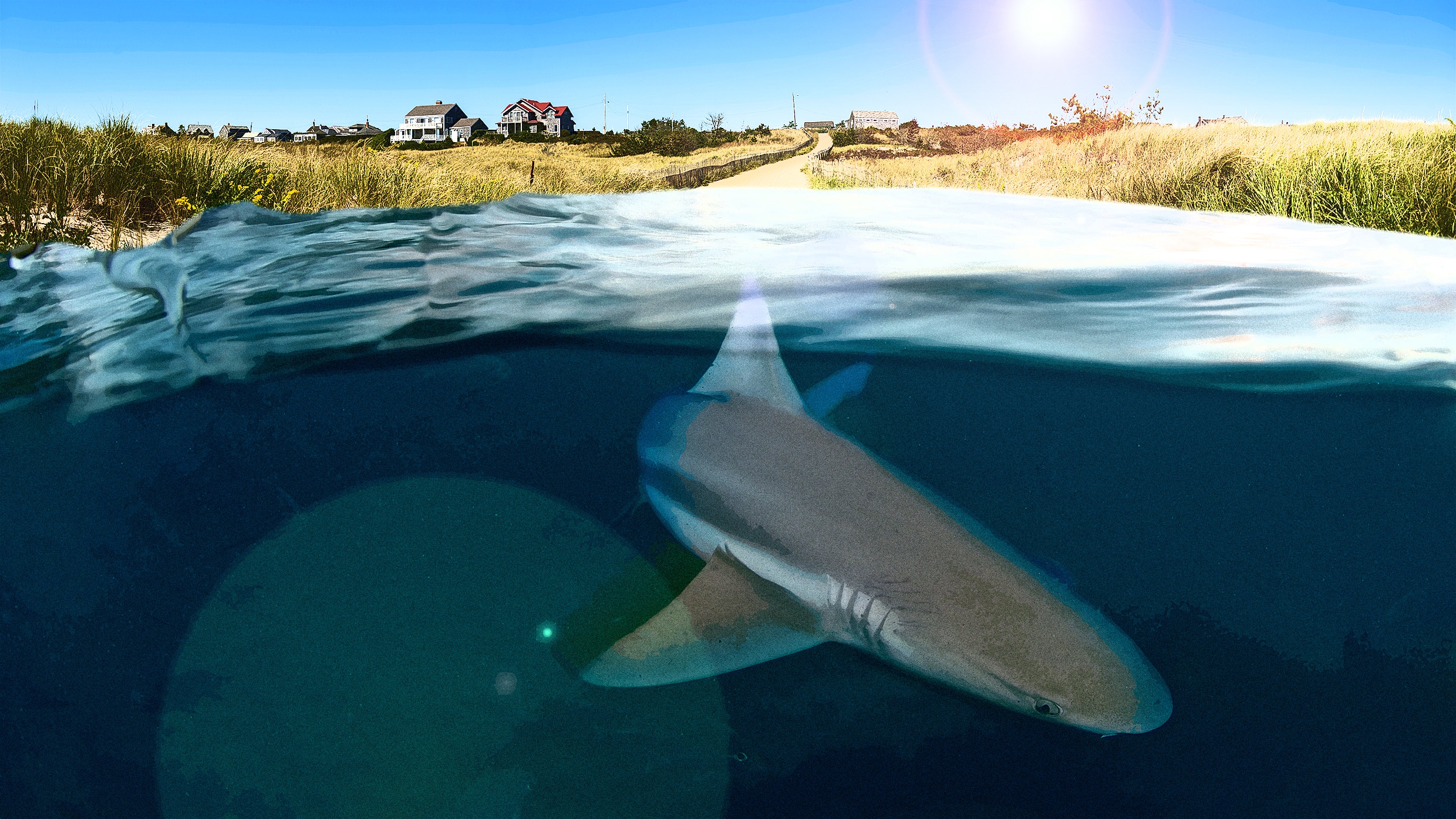Shark sightings are on the rise at Northeast beaches. Here’s how climate change plays a part
After a spate of shark sightings (and attacks) on the July 4 weekend, the New York governor’s office announced it will deploy dozens of drones at local beaches in Long Island and New York City to track shark movements, an expansion from the eight announced last year. The governor also announced more watercraft patrols, buffer zones, and new safety guidance for beachgoers—including tips to avoiding murky water and seals.
Shark sightings have increased on U.S. coastlines the past two summers, especially in the North Atlantic off of Long Island and Cape Cod, and stretching up to Eastern Canada. There are several factors, but climate change is one of the main drivers, experts say, because northern waters now provide warmer temperatures for the predators. The new distribution patterns of sharks will likely have an effect on ocean ecosystems, as well as on possible interactions with humans.

While it’s largely anecdotal, there’s been an abundance of shark sightings this summer in the Northeast. On the July 4 weekend, 50 sand sharks were spotted on one beach in Long Island, and four shark bites were reported off of Long Island beaches, including one near the Hamptons and one off of Fire Island. Further north, the sight of great white sharks prompted swimming prohibitions at Cape Cod beaches and a Nantucket wildlife refuge. This all builds on last year’s surge in sightings—and a record number of bites in New York—which Slate called “the summer everyone saw the sharks.”
Experts say it’s extremely difficult to pin down one reason, such as climate change, for the increased sightings. There are a multitude of factors at play, from overfishing to the rebounding of prey in certain areas. And each of the more than 500 species of shark behaves differently. “It’s really hard to disentangle [climate change] from all of the other potential drivers,” says Taylor Chapple, assistant professor at the Marine, Fishing and Wildlife Department at Oregon State University. Still, climate change is having some effects.
How climate change is affecting shark movements
While research is still slim, experts increasingly think climate change is a particular driver of shark movements. Climate change affects elements like water temperature, oxygen, and acidity. Chapple says many sharks are resilient to some of these shifts: Some sharks, for example, can hold their breath while foraging, adapting to less oxygen in warmer water. But as predators, they will move to follow their prey—and their prey, such as salmon, herring, and squid, may be less adaptable.
Many sharks will be directly affected by ocean warming as well, and will move to waters with temperatures that are more optimal for their metabolisms. Most sharks are cold blooded, so they rely on environmental temperatures for their bodies to operate well, and naturally gravitate to warmer water. And as the Gulf of Maine, around the Northeast U.S. and Canada, is warming at a faster rate than 99% of the world’s oceans, it’s become a haven for some sharks.
A few recent studies have made the connection between climate and certain shark species. Stephen Kajiura, a professor of biological sciences at Florida Atlantic University, has been aerially tracking blacktip sharks for more than a decade. Previously, blacktips used to congregate en masse around South Florida in the winter but then disappear in the summer. Kajiura wanted to find out where they went.

He discovered that they are swimming to the North Atlantic, off Long Island—way further north than North Carolina, where scientists previously thought was the limit of their travel. These sharks have a relatively low thermal tolerance, at about 73 to 77 degrees Fahrenheit. “As the ocean temperatures have been climbing, they are encountering that preferred temperature at higher and higher latitudes,” Kajiura says. And fewer than before will return back to Florida: “Why swim an extra hundred kilometers if I don’t have to?”
Similarly, Neil Hammerschlag, former director of the Shark Research and Conservation Program at the University of Miami, ran a study in 2021 that focused on tiger sharks. He found they were moving into Northeast waters where it was historically too cold—and that they were doing so earlier in the season. In the past decade, for every one degree Celsius above the long-term average, the sharks moved up by nearly four degrees latitude, and 14 days earlier than previously.
“We do definitely know that there’s a link between temperature and movement,” he says. “That’s a very, very, very, very strong driver. Probably the strongest driver of shark movements.”
Hammerschlag himself has now moved to Nova Scotia, Canada, to conduct his own independent shark research trips. He made the move partly because great white sharks have made the very same migration; he jokes that Florida got too hot for both him and the sharks. (There are also other reasons for the resurgence of great whites in that area, including a recent rebound of prey like seals, due to the success of the Marine Mammal Protection Act.)
What the new distribution of sharks means for ocean life—and for us
It’s not that climate change is increasing shark populations, but rather it’s affecting the distributions of those populations. This may be causing effects on ecosystems and food webs—both where they are moving to and departing from. But that’s yet to be determined; there are too many “moving parts” to even run models, Kajiura says. “We’re kind of running blind and just looking after the fact,” he says.
The fact that certain sharks are thriving, even in different locations, is a positive, Chapple says—a sign that the ocean system in its current state can support the predators in consistent numbers, as well as all their prey. “You can’t have lions on the Serengeti unless you have a strong prey base underneath them that goes all the way down to the grasses,” he says.
Another consequence of this new distribution of sharks is that we may see more sharks around the places we frequent in the summer. Chapple stresses that there is still a low chance of attacks; more sightings does not necessarily mean more bites. He says there are more sightings now partly because we have more technology to capture sharks and notify the public, such as via videos and text alerts. Recent drones in California showed great whites swimming right underneath surfers without incident; this may have been happening before, but we simply didn’t know they were there.
Shark bite data remains relatively low. In fact, according to the University of Florida’s International Shark Attack File (ISAF), 2022 was a five-year low for attacks. “While they can be catastrophic for the folks involved, it’s highly, highly unlikely that anything is ever going to happen to you,” Chapple says. A report using other ISAF data wryly noted that we’re more likely to die from falling out of bed, getting struck by lightning, or by a cow than by a shark.
But the same 2022 ISAF data did show that shark bites have spiked in regional hotspots, including a record eight bites in New York. This is likely because the sharks are overlapping more with where people actually are, like the heavily populated areas around the beaches of New York and Massachusetts. “Shark bites are influenced by people’s use of the water,” Hammerschlag says. “You can’t have a shark bite without someone in the water.”

So, more human interactions may naturally mean more bites. It’s usually not intentional; water in the Northeast is murkier than the clear Florida water, meaning sharks like blacktips sometimes mistake a human body part for food. “You’ve got something moving in the water,” Kajiura says, “and they tend to investigate with their mouths.”
Without being alarmist, experts do say it is good practice to warn the public to exercise caution in the water, like by not wading out too deep, avoiding sandbars, and not wearing shiny jewelry, which sharks can mistake for fish scales.
“It’s helpful to people to inform [the public] that the world is changing, the ocean is changing,” Kajiura says. “This is not the same beach it was when you were a little kid.”
(13)



